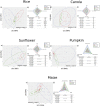Domesticated, Genetically Engineered, and Wild Plant Relatives Exhibit Unintended Phenotypic Differences: A Comparative Meta-Analysis Profiling Rice, Canola, Maize, Sunflower, and Pumpkin
- PMID: 29259610
- PMCID: PMC5723393
- DOI: 10.3389/fpls.2017.02030
Domesticated, Genetically Engineered, and Wild Plant Relatives Exhibit Unintended Phenotypic Differences: A Comparative Meta-Analysis Profiling Rice, Canola, Maize, Sunflower, and Pumpkin
Abstract
Agronomic management of plants is a powerful evolutionary force acting on their populations. The management of cultivated plants is carried out by the traditional process of human selection or plant breeding and, more recently, by the technologies used in genetic engineering (GE). Even though crop modification through GE is aimed at specific traits, it is possible that other non-target traits can be affected by genetic modification due to the complex regulatory processes of plant metabolism and development. In this study, we conducted a meta-analysis profiling the phenotypic consequences of plant breeding and GE, and compared modified cultivars with wild relatives in five crops of global economic and cultural importance: rice, maize, canola, sunflower, and pumpkin. For these five species, we analyzed the literature with documentation of phenotypic traits that are potentially related to fitness for the same species in comparable conditions. The information was analyzed to evaluate whether the different processes of modification had influenced the phenotype in such a way as to cause statistical differences in the state of specific phenotypic traits or grouping of the organisms depending on their genetic origin [wild, domesticated with genetic engineering (domGE), and domesticated without genetic engineering (domNGE)]. In addition, we tested the hypothesis that, given that transgenic plants are a construct designed to impact, in many cases, a single trait of the plant (e.g., lepidopteran resistance), the phenotypic differences between domGE and domNGE would be either less (or inexistent) than between the wild and domesticated relatives (either domGE or domNGE). We conclude that (1) genetic modification (either by selective breeding or GE) can be traced phenotypically when comparing wild relatives with their domesticated relatives (domGE and domNGE) and (2) the existence and the magnitude of the phenotypic differences between domGE and domNGE of the same crop suggest consequences of genetic modification beyond the target trait(s).
Keywords: Brassica napus; Cucurbita pepo; Helianthus annuus; Oryza sativa; Zea mays; genotype–phenotype; phenotypic profiling; unintended phenotypic effects.
Figures

Similar articles
-
Safety and nutritional assessment of GM plants and derived food and feed: the role of animal feeding trials.Food Chem Toxicol. 2008 Mar;46 Suppl 1:S2-70. doi: 10.1016/j.fct.2008.02.008. Epub 2008 Feb 13. Food Chem Toxicol. 2008. PMID: 18328408 Review.
-
Plant breeding involving genetic engineering does not result in unacceptable unintended effects in rice relative to conventional cross-breeding.Plant J. 2020 Sep;103(6):2236-2249. doi: 10.1111/tpj.14895. Epub 2020 Jul 19. Plant J. 2020. PMID: 32593184 Free PMC article.
-
Quantitative trait locus analysis of the early domestication of sunflower.Genetics. 2007 Aug;176(4):2589-99. doi: 10.1534/genetics.107.075333. Epub 2007 Jun 11. Genetics. 2007. PMID: 17565965 Free PMC article.
-
Risk assessment of genetically engineered crops: fitness effects of virus-resistance transgenes in wild Cucurbita pepo.Ecol Appl. 2009 Jul;19(5):1091-101. doi: 10.1890/08-0105.1. Ecol Appl. 2009. PMID: 19688918
-
Could abiotic stress tolerance in wild relatives of rice be used to improve Oryza sativa?Plant Sci. 2014 Feb;215-216:48-58. doi: 10.1016/j.plantsci.2013.10.007. Epub 2013 Oct 21. Plant Sci. 2014. PMID: 24388514 Review.
Cited by
-
Residual Effects of Transgenic Cotton on the Intestinal Microbiota of Dysdercus concinnus.Microorganisms. 2023 Jan 19;11(2):261. doi: 10.3390/microorganisms11020261. Microorganisms. 2023. PMID: 36838225 Free PMC article.
-
Genomics yields fresh insights on plant domestication: Understanding the process of domestication can help to guide breeding efforts in plants.EMBO Rep. 2018 Nov;19(11):e47153. doi: 10.15252/embr.201847153. Epub 2018 Oct 22. EMBO Rep. 2018. PMID: 30348890 Free PMC article.
-
The Mating System of the Wild-to-Domesticated Complex of Gossypium hirsutum L. Is Mixed.Front Plant Sci. 2018 May 9;9:574. doi: 10.3389/fpls.2018.00574. eCollection 2018. Front Plant Sci. 2018. PMID: 29868048 Free PMC article.
-
Genetic analysis and QTL mapping of domestication-related traits in chili pepper (Capsicum annuum L.).Front Genet. 2023 May 15;14:1101401. doi: 10.3389/fgene.2023.1101401. eCollection 2023. Front Genet. 2023. PMID: 37255716 Free PMC article.
-
Molecular evidence provides new insights into the evolutionary origin of an ancient traditional Chinese medicine, the domesticated "Baizhi".Front Plant Sci. 2024 May 8;15:1388586. doi: 10.3389/fpls.2024.1388586. eCollection 2024. Front Plant Sci. 2024. PMID: 38779069 Free PMC article.
References
LinkOut - more resources
Full Text Sources
Other Literature Sources

